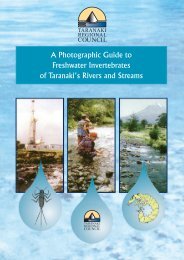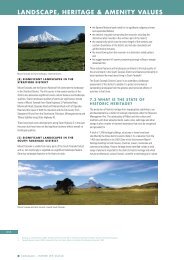Annual report 2006-2007 - Taranaki Regional Council
Annual report 2006-2007 - Taranaki Regional Council
Annual report 2006-2007 - Taranaki Regional Council
Create successful ePaper yourself
Turn your PDF publications into a flip-book with our unique Google optimized e-Paper software.
45<br />
ecosystems at similar hardness (30 g/m 3 CaCO3) (Figure 16 and Table 12). Elevated<br />
zinc levels have been recorded at this site in the past (Figure 16) but have been below<br />
guideline values since 1999.<br />
Zinc (g/m 3 )<br />
0.035<br />
0.03<br />
0.025<br />
0.02<br />
0.015<br />
0.01<br />
0.005<br />
0<br />
Zinc concentrations in tributary of Kahouri Stream<br />
upstream of Kahouri confluence (KHI000369)<br />
Jun-91<br />
Jun-92<br />
Jun-93<br />
Jun-94<br />
Jun-95<br />
Jun-96<br />
Jun-97<br />
Jun-98<br />
Jun-99<br />
Jun-00<br />
Jun-01<br />
Jun-02<br />
Jun-03<br />
Jun-04<br />
Jun-05<br />
Jun-06<br />
Zinc - acid soluble Zinc - dissolved ANZECC USEPA<br />
Figure 16 Zinc concentrations in tributary upstream of confluence with Kahouri Stream<br />
Biological survey<br />
A macroinvertebrate sample was collected from site D (Figure 1) in the tributary 800<br />
m downstream of <strong>Taranaki</strong> Galvanizers on 17 April <strong>2007</strong>. The sample was sorted and<br />
identified to provide the number of taxa (richness), MCI and SQMCIS scores for each<br />
site.<br />
The MCI is a measure of the overall sensitivity of the macroinvertebrate community<br />
to the effects of organic pollution in stony streams. It is based on the<br />
presence/absence of taxa with varying degrees of sensitivity to environmental<br />
conditions. It may be used in soft-bottomed streams to detect trends over time. The<br />
SQMCIS takes into account taxa abundance as well as sensitivity to pollution, and<br />
may reveal more subtle changes in communities, particularly if non-organic impacts<br />
are occurring. Significant differences in either MCI or SQMCIS between sites indicate<br />
the degree of adverse effects (if any) of discharges being monitored.<br />
The stream at this site had a cloudy flow, with substrate comprising hard clay and<br />
tree roots. Prior to the survey there was a reasonable period of flow recession, being<br />
93 days since a flood in excess of 3 times median flow had occurred.<br />
Site D in the Kahouri Stream tributary would be expected to support ‘poorer’<br />
macroinvertebrate communities than those of the Kahouri Stream due to the clay<br />
substrate, but in this survey the community contained many ‘sensitive’ taxa and had<br />
relatively high MCI and SQMCIs scores, indicating no detrimental effects from<br />
discharges in the Stratford industrial area in the upper part of the tributary which<br />
includes discharges from <strong>Taranaki</strong> Galvanizers, Egmont Tanneries and Firth<br />
Industries.<br />
A full biological <strong>report</strong> is given in Appendix II.














